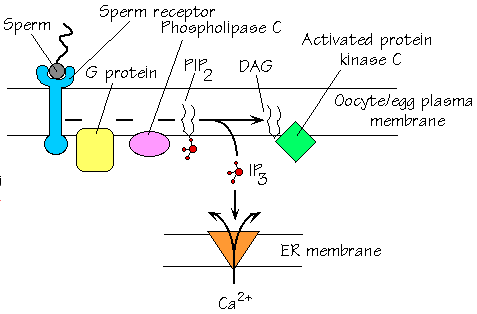

A sequence of successive stages during Xenopus egg activation in response to local injection of IP3. The IP3 was injected at the right of the oocyte. Red indicates high levels of calcium; blue indicates low levels. A caclium iondicator dyew is used to assess calcium levels within the egg.
Egg activation in most species is thought to involve a series of similar signal transduction steps after sperm binds to a receptor protein on the egg/oocyte surface. One of the steps that is thought to be crucial for subsequent release of calcium from internal stores (typically, the endoplasmic reticulum, or ER) is the production of inositol triphosphate (IP3) from PIP2 residing in the egg plasma membrane. The cleavage of PIP2 into IP3 and diacylglycerol (DAG) results in numerous "downstream" events ã IP3 is thought to stimulate local release of calcium ions from the ER, resulting in the "calcium activation wave" as a transient rise in calcium sweeps across the egg. The movie sequence shown here, compiled from published still micrographs by Drs. Carolyn Larabell and and Richard Nuccitelli (Larabell, C. and Nuccitelli, R., 1992. Inositol lipid hydrolysis contributes to the Ca wave in the activating egg of Xenopus laevis. Dev. Biol. 153, 347-355) demonstrates that local injection of exogenous IP3 into a Xenopus oocyte can result in in the generation of a calcium wave.
